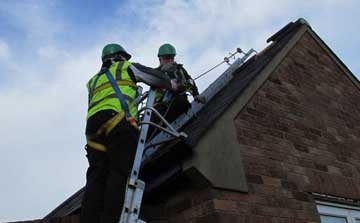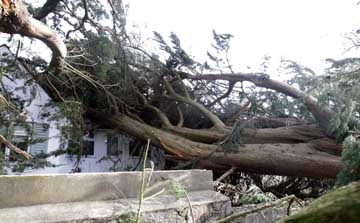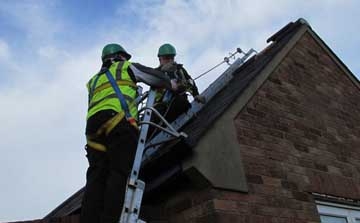You are viewing 1 of your 1 free articles
Damage control after storm damage in Wales
Recent bad weather hit hard in Wales, damaging 10 per cent of one social landlord’s homes. Martin Hilditch finds out how it is coping
The weather was already treacherous when out-of-hours operative Wynne Parry arrived at a house where storm damage had been reported at 10.30pm on Boxing Day 2013.
He describes the scenes that greeted him as he drove his van into the cul-de-sac of houses in Caernarfon, in Gwynedd, north Wales as ‘scary’. ‘It was like something out of a film,’ he says.
Mr Parry, who works for 6,300-home association Cartrefi Cymunedol Gwynedd, which has its headquarters in Bangor, was responding to a call from a tenant that some slates had been blown off his roof. He’d headed over in heavy winds in order to ‘see what we were up against’. As he knocked to announce his presence, the front door was flung open and the occupier grabbed Mr Parry and pulled him inside.
‘I thought, this is a bit strange,’ Mr Parry says. It quickly became apparent, however, that the tenant Mr Parry had arrived to help was in fact taking immediate action to protect his life. After hauling Mr Parry to the relative safety of his doorway, the pair turned to look back at the street.
‘As I stood by the door, we watched the slates and roofing tiles starting to come off the roofs,’ Mr Parry says. ‘Obviously, he had known that things were coming down off his roof as well. There were slates sticking up [after becoming embedded in the ground] all over the place.’
Dangerous conditions
From this point on Mr Parry describes the rest of the night as ‘mayhem’. He carried on answering calls from worried tenants, despite the storm, for another couple of hours. His last call was to a home in Erw Faen, Tregarth, at about 2.30am.
‘I was greeted by a tenant who was absolutely petrified because they said the whole structure of the house had moved,’ he states. ‘By 2am, everywhere you went it was pandemonium.’ After the 2.30am call, he went home after risk-assessing the situation and agreeing with a stand-by officer that it was too dangerous for him to continue.
He was back up and out again at 7.30am - by which time the extent of the damage was all too obvious. ‘People were out just looking stunned,’ he says. ‘People’s fences were ripped off completely. Greenhouses had blown over. Some [houses] had chimneys come through the roof. It was like a whirlwind had gone through.’
His employer was also waking up to its own storm-inflicted headache. It estimates that more than 400 of its 6,300 homes were damaged in one night. And last week, just as it was beginning to count the cost, Gwynedd was battered by storms again. This time an estimated 300 homes were damaged - many in different locations to the initial thumping, meaning that up to 700 may have been damaged in total, well over 10 per cent of the housing association’s entire stock.
So how does a landlord begin to cope with this scale of damage in the following days and weeks? And what impact does it have on its existing plans for 2014, such as meeting the Welsh housing quality standard?
Ffrancon Williams, Cartrefi Cymunedol Gwynedd’s chief executive, meets Inside Housing a week before the second storm hits - at the time of going to press, the association was just coming to terms with the destructive impact of yet another pounding by Mother Nature. He admits that the ‘tremendous storms’ on Boxing Day meant everyone was expecting the worst when they got up the next day. ‘We knew it was bad,’ he states. ‘It was hairy out there.’
Mr Williams woke up to the news that alarms set off by the storm were ringing at the association’s head office, which was closed for the Christmas period. Because of the time of the year, there was only one stand-by operative on duty. Unable to get hold of him on his mobile, Mr Williams eventually contacted the operative on his home number. He told Mr Williams that he had been unable to access the association’s computer system that morning and it quickly became apparent that the organisation’s computer network had crashed. ‘Our phone system is hosted by computer,’ Mr Williams says. So tenants whose homes had been damaged were unable to call their landlord to report it. As the association mobilised its IT team to fix the problem, it wasn’t just tenants who wanted to talk to Mr Williams and his colleagues.
Emergency calls
‘By this stage, I had received calls from the emergency services,’ he states. ‘They were saying that they were receiving calls from tenants because they couldn’t get through to us on the phone. We had to come to an agreement with our standby officer to use a different number as a temporary fix.’
The new number was advertised on Facebook and Twitter - but this was far from ideal in terms of reaching all tenants. ‘It was a worrying period,’ Mr Williams admits. Tenants who got through on the new number - or via social media - were reporting a variety of problems such as water leaking into their homes, missing roof tiles and damage to chimney pots. But the ‘temporary fix’ phone system was struggling to cope and not every tenant could get through.
‘By that point, we were back in control but we didn’t know how big the problem was,’ Mr Williams states. ‘We were gradually mobilising more people [staff] to help. Because the mobile network was down, we had to resort to ringing them at home.’
Staff, who up until this point had been anticipating a week off work, were suddenly facing an abrupt end to their holidays. ‘Our call centre staff all came in,’ Mr Williams says. They took a total of 272 calls from residents over the four days from 28 December - a figure that doesn’t include the emergency calls taken by the out-of-hours service on the day immediately after the storm. Twenty-three of these later calls were given top priority, meaning there was ‘roof damage and unsafe or hanging slates or tiles’ and a further 15 were given priority two (in a five-band system) which meant they had leaking roofs or internal damage. It was homes such as these, in a potentially dangerous condition, that had to receive immediate attention. Amid the effort to tackle hundreds of damaged properties, however, repairs staff were reminded to record precise details of the homes they visited and the damage reported and the hours they worked - vital information if the landlord is to make a successful insurance claim.
Taking action
Tenant Anwen McKenzie, 55, was one of the residents whose house was damaged. ‘I had one of those ridge tiles that went flying,’ she says from her Caernarfon bungalow. The tile flew off the roof and embedded itself in her lawn, without breaking - a vivid warning of the danger to life to anyone who ventured outside on the night.
‘I was terrified,’ she admits, before singing the praises of the association’s staff who responded to her call and who ‘I can’t fault whatsoever’.

Source: Robert Parry Jones
Cartrefi employees carry out repair work on tenant Anwen McKenzie’s roof in Caernarfon
Chris Furlong, head of repairs at the association, says the staff did a tremendous job under pressure. ‘Most of the [95] guys in our direct labour organisation [Tîm Trwsio] live and work in Bangor,’ he says. ‘They had their own issues [due to the weather] but they came out and did the job.’ Because the wind was so high, it was too dangerous for any operatives to climb on roofs the following day, so work to make properties watertight had to be carried out from inside residents’ homes.
The association owns 1,041 homes in Caernarfon and 92 in Barmouth, the worst-hit areas.
As the initial crisis cases were dealt with, however, other issues still had to be addressed. For a start, the association had to work out exactly how much damage there had been; not all tenants would notice or necessarily report tiles that had flown off their roofs, for example.
To deal with this the association has hired surveyors to visit its estates and assess the full impact of the storms. At the time of last week’s second storm, they were coming to the end of the process of surveying some 2,000 homes that could potentially have been hit. Once the full scale of the problem is known, the intention is to put the repair work out to tender. ‘Because of the volume, we are packaging the work,’ Mr Williams explains.
This - plus the fact that the initial storm struck during the Christmas holidays when the association was closed - means the landlord’s planned work to improve homes to the Welsh housing quality standard was not affected by the first storm.
However, following last week’s storm, the organisation says the extent of the damage is ‘worse’ with roofs blown off garages and many more collapsed chimney stacks. The association also lost all power to its Bangor office, which meant its call centre couldn’t take calls until Thursday lunchtime.
Mr Furlong says it is again ‘having to prioritise in order to tackle the worst-hit areas and emergencies first’ and that it asked its customers to ‘be patient with us’. Residents were asked only to call for the first few days if they considered their repairs to be ‘urgent’.
Meanwhile, as it pulls itself together again and sets to the job in hand, the landlord can only hope the worst of the weather has now gone. Either way, it will be dealing with the impact for months to come.
‘I’ve worked in asset management for about 20 years,’ Mr Furlong adds. ‘In terms of proportion of stock damaged, I have never seen anything like this.’










